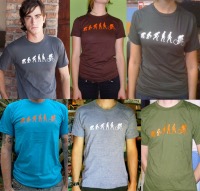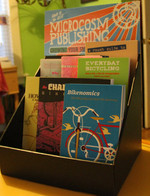Indie Bookstore Love: Boneshaker Books in Minneapolis!
 Our indie bookstore crush for the month of April is on Minneapolis’s one-and-only all-volunteer bookstore collective, Boneshaker Books. Walking into Boneshaker is an amazing experience—a friendly person greets you, and you’re surrounded by a selection of books, each one of which was obviously chosen because someone passionately wants you to read it, not because of sales metrics. Even the way the sections are selected is thoughtful and eye-opening. For instance, most bookstores have a separate sections for African American and Native American histories… in Boneshaker, those are both just plain American History, and make up the bulk of that section. Chances are a volunteer worker will make you feel right at home, leaving you alone to browse if that’s what you prefer or engaging in a spirited discussion of the ethics and techniques of writing fiction, if that’s up your alley.
Our indie bookstore crush for the month of April is on Minneapolis’s one-and-only all-volunteer bookstore collective, Boneshaker Books. Walking into Boneshaker is an amazing experience—a friendly person greets you, and you’re surrounded by a selection of books, each one of which was obviously chosen because someone passionately wants you to read it, not because of sales metrics. Even the way the sections are selected is thoughtful and eye-opening. For instance, most bookstores have a separate sections for African American and Native American histories… in Boneshaker, those are both just plain American History, and make up the bulk of that section. Chances are a volunteer worker will make you feel right at home, leaving you alone to browse if that’s what you prefer or engaging in a spirited discussion of the ethics and techniques of writing fiction, if that’s up your alley.
The collective is putting up a Microcosm books display this month to celebrate our shared history and values (pics coming once that happens!), and they also took the time to answer a few questions for us.
1. What is the history of Boneshaker Books?
After longtime Minneapolis radical bookstore Arise! closed in 2010, a group of former volunteers decided that there was still a need for an all-volunteer community bookstore—and, that if done thoughtfully, it could be successful and self-sustaining. Our original crew had an extremely diverse skill set that included a professional fundraiser, a carpenter, an artisanal iron worker, and a web developer, and we leveraged those skills as much as possible.
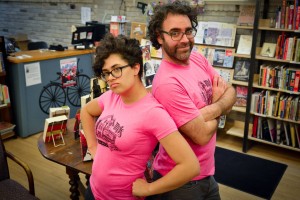 Along with the usual Kickstarter and benefit events, we came up with a unique fundraising plan: every donor of $250 or more could pick a book title that we would stock forever. So not only did we build a strong donor base, but they literally built the foundation (or skeleton) of our collection. We like to say that every book in the store is there because someone—donor or volunteer—loves it.
Along with the usual Kickstarter and benefit events, we came up with a unique fundraising plan: every donor of $250 or more could pick a book title that we would stock forever. So not only did we build a strong donor base, but they literally built the foundation (or skeleton) of our collection. We like to say that every book in the store is there because someone—donor or volunteer—loves it.
We intended to open in the old Arise! Bookstore building, but it fell through for a few reasons, mostly due to money. After contacting some neighborhood groups, we found an odd space in the back of a quirky building in the Seward neighborhood, near our friends at the Seward Cafe. It turned out to be a perfectly magical fit. We were also able to share the space with our friends at the Women’s Prison Book Project who distribute books to women and transgender persons in prisons.
After a year of writing business plans, fundraising, building beautiful custom bookshelves, and making dreamy book lists, we opened in January of 2011. Over the last five years, we’ve sold thousands of books, hosted hundreds of events, meetings and book clubs, and thrived with the support of countless volunteers and patrons. It’s been a wild ride, and we look forward to the adventures the next five bring.
2. A boneshaker is a Victorian-era bicycle; we too love the combination of books and bicycles. How did you choose the name and what do bikes + books mean to you?
So one of the ideas that we included in our vision of Boneshaker Books from our earliest collective meetings was to offer a free bike delivery service for special orders. Many of our founding collective members rode their bikes for transportation already, and it just seemed like a natural addition to our store. So as we discussed that intersection of interests, we gravitated towards a bike/book name.
And as we thought more about that combination, we thought about the ideological similarities between riding bikes and reading books. Today, neither of those things is seen as essential to enjoying your life—but anyone who rides a bike or reads a book will tell you how empowering those activities are! How they are essential to so many of us!
Riding a boneshaker bike is also a really jarring experience, which we think describes our inventory pretty well. We carry books that rattle your core, and the name Boneshaker Books fits that perfectly.
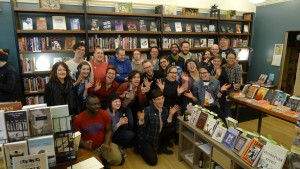 3. What’s your favorite (or the most popular) Microcosm book in your store? How about any book at all?
3. What’s your favorite (or the most popular) Microcosm book in your store? How about any book at all?
So this might be a little biased, but our favorite Microcosm book is Fire and Ice by Joshua Ploeg. In 2012 we were hosting a Valentine’s Day fund raising dinner—and maybe not surprisingly, we don’t have a ton of experience catering gigantic dinners. But it turned out that Joshua was going to be in Minneapolis that night, so we reached out and asked for his help.
And he pulled through in such a huge way! He helped us make the most incredible vegan dinner, with, like, Husker Du themed foods! And then one of his fans showed up, this awesome vegan chef from Minneapolis, and she cooked a ton of delicious food with us, too. It was just this totally overwhelming experience, and it still stands as our most successful fund raiser ever, four years later.
Fire and Ice happens to be our best selling Microcosm title too—which is nice.
4. You’ve been around through some major ups and downs in the book business. Has being a volunteer-run collective helped get you through that or given you a different perspective than a for-profit bookstore might have? What do you hope happens next?
At any given time we have over 40 active volunteers, and sometimes that number goes up to 60. That means every day there are between 40 and 60 people who are contributing ideas, recommending books, organizing events, and making Boneshaker Books a better community book store.
So that’s probably the biggest perspective-shift between Boneshaker and a for-profit bookstore. We have more ideas coming in, we have a more diverse set of stake holders, and—as volunteers—we’re less dictated by making stacks of cash. We need to pay rent every month, but other than that, we don’t have nearly as many expenses as a traditional bookstore—and that lets us take risks with our inventory that wouldn’t be possible otherwise.
Our next big hopes are to expand our bicycle delivery service to include a dedicated bike trailer stocked for events, and we’re dipping our feet into online sales. Maybe.
Visit Boneshaker Books every day from 11 to 8 at 2002 23rd Ave S in the Seward neighborhood of Minneapolis, Minnesota! And thank you for supporting independent bookstores!
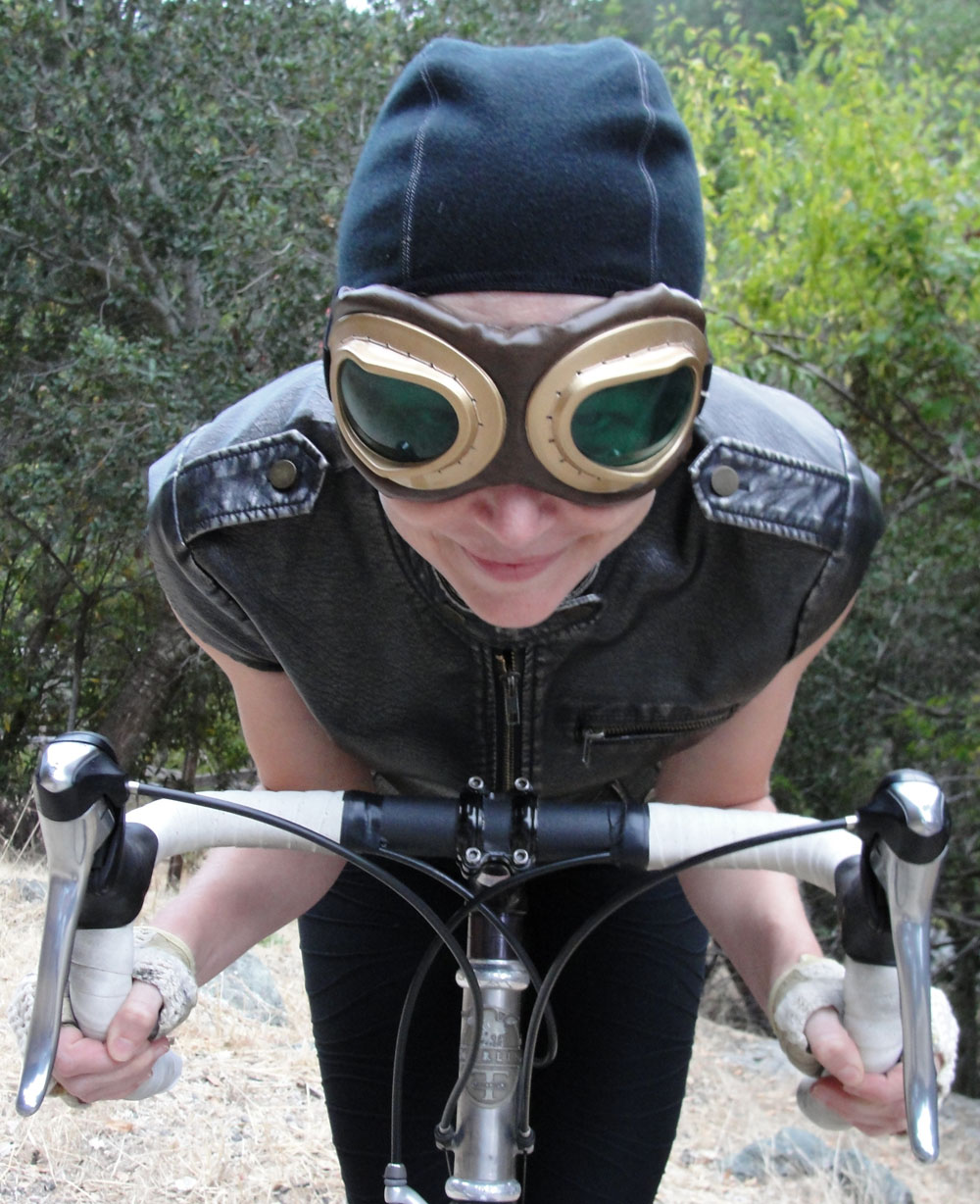 “A tough girl rebels against stifling gender rules in a quasi-historical steampunk world, dreaming of racing her bicycle in the cutthroat velocipede races. But can her dream survive scandal, scrutiny, and heartbreak?” That’s how
“A tough girl rebels against stifling gender rules in a quasi-historical steampunk world, dreaming of racing her bicycle in the cutthroat velocipede races. But can her dream survive scandal, scrutiny, and heartbreak?” That’s how 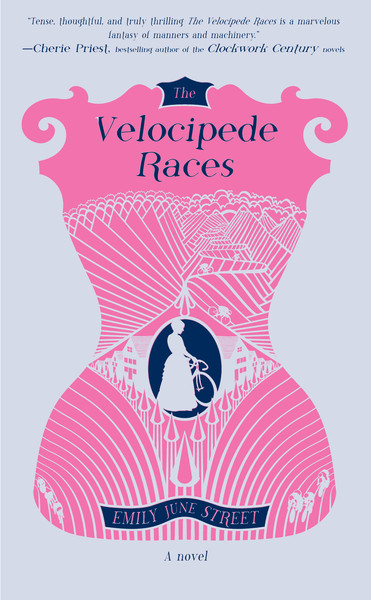
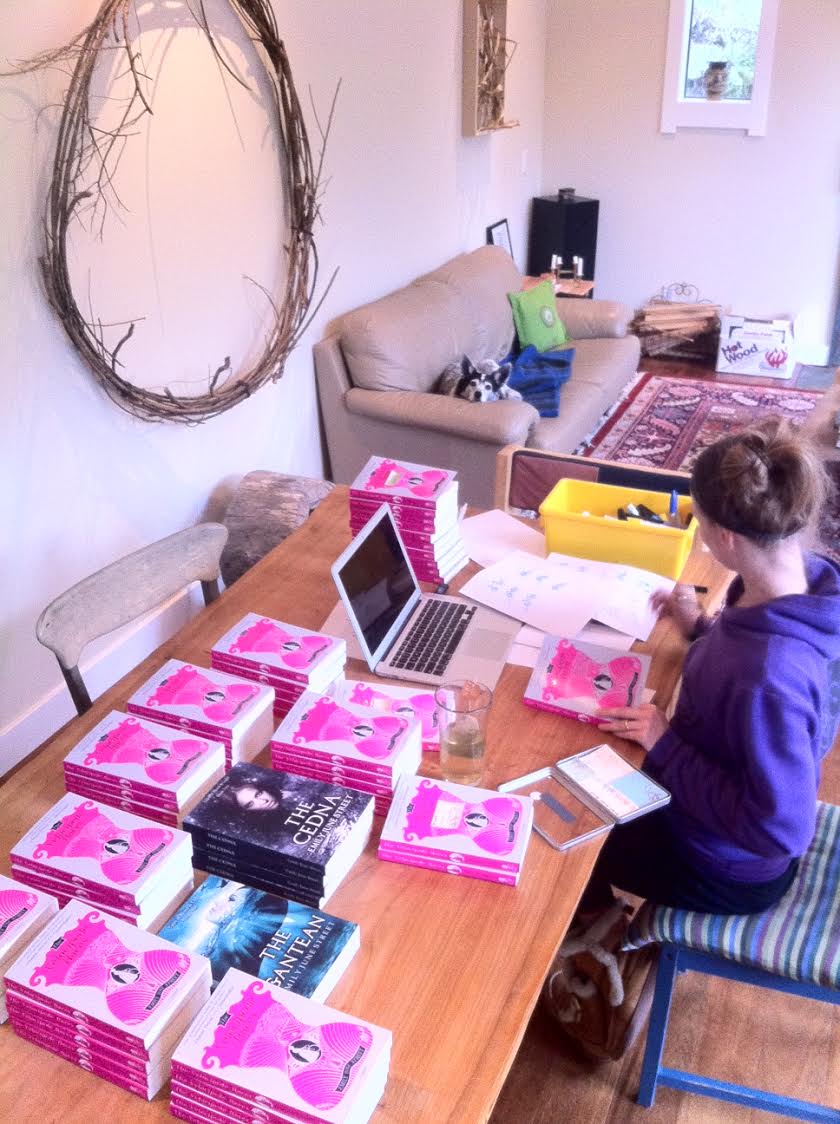
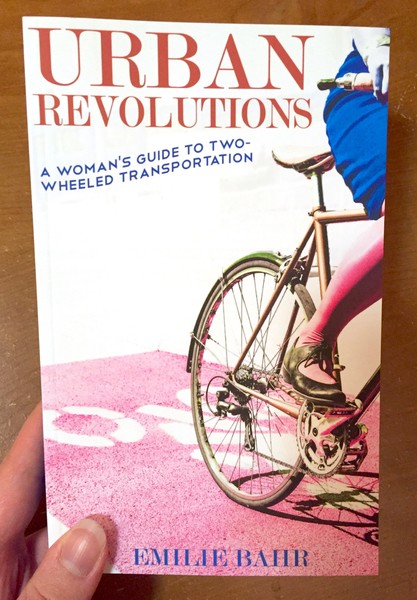 Emilie Bahr’s new book
Emilie Bahr’s new book 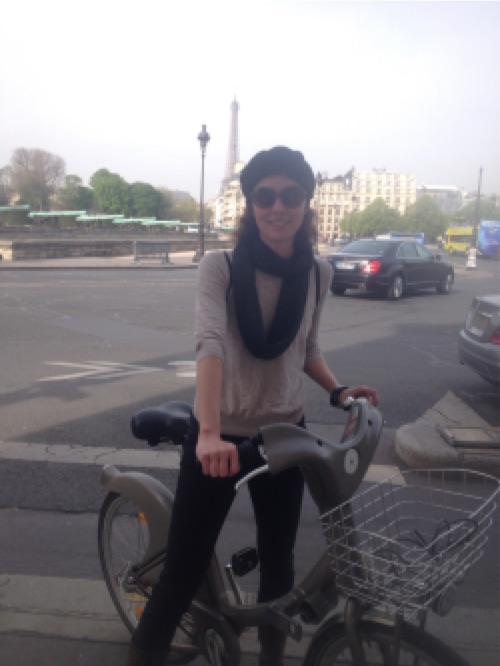 2. The book’s subtitle is “A Woman’s Guide to Two-Wheeled Transportation.” Why that subtitle? Is the book only for women?
2. The book’s subtitle is “A Woman’s Guide to Two-Wheeled Transportation.” Why that subtitle? Is the book only for women? What’s also important to note about New Orleans is that we’re a poor city. Our poverty rate is significantly higher than the national average and a large proportion of people don’t have access to cars, so there are a number of people who get around by bike and have for many years before the infrastructure was installed because they have no other option. I would say that our bicycling community is very racially and economically diverse, which is increasingly true across the country, but New Orleans bicyclists really defy the stereotype of bicyclist as wealthy, white male. More and more, I notice a whole lot of women biking here too.
What’s also important to note about New Orleans is that we’re a poor city. Our poverty rate is significantly higher than the national average and a large proportion of people don’t have access to cars, so there are a number of people who get around by bike and have for many years before the infrastructure was installed because they have no other option. I would say that our bicycling community is very racially and economically diverse, which is increasingly true across the country, but New Orleans bicyclists really defy the stereotype of bicyclist as wealthy, white male. More and more, I notice a whole lot of women biking here too.
 Of the fifty-plus contributors to our brand-new book
Of the fifty-plus contributors to our brand-new book 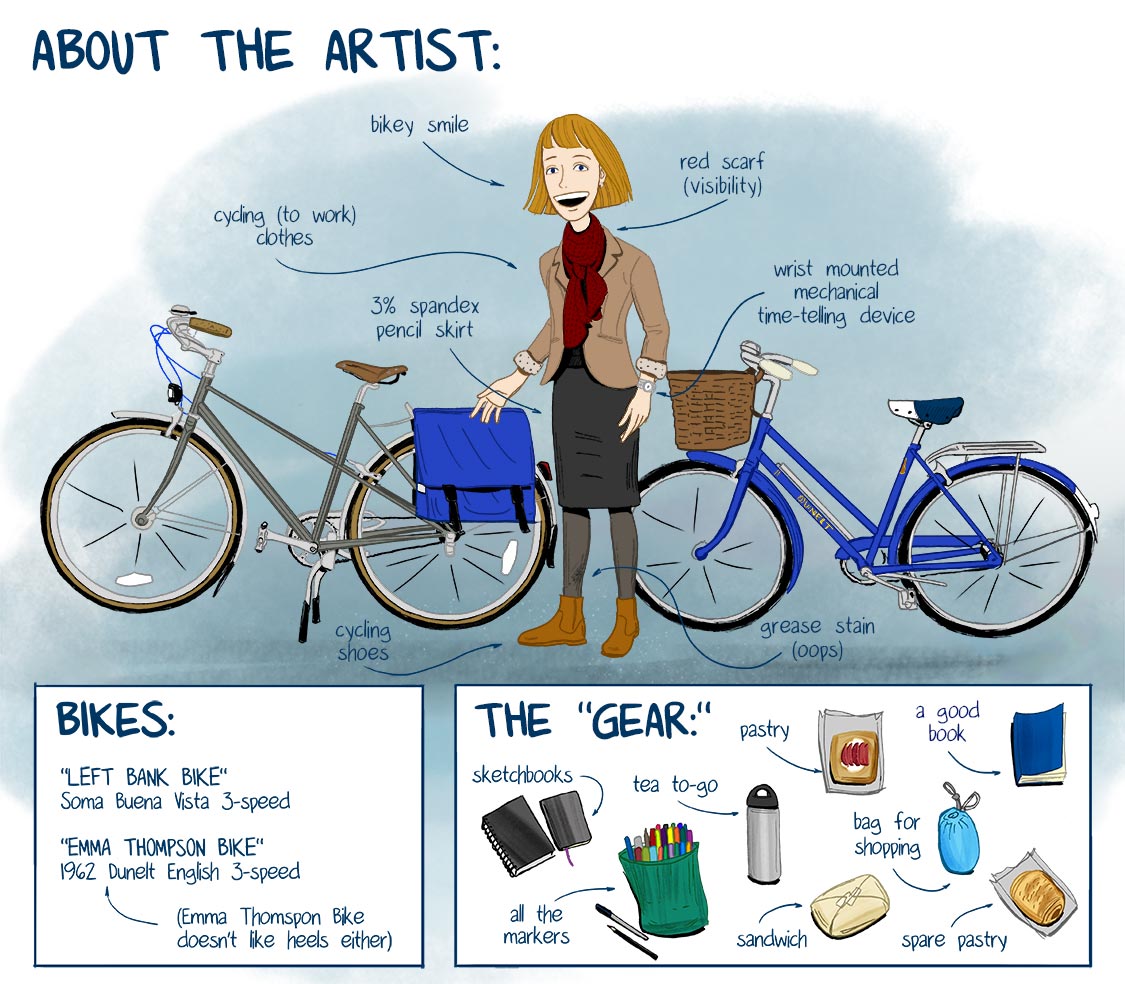 3. What’s your favorite comic that you’ve drawn? What (if it’s different) has been the most popular one?
3. What’s your favorite comic that you’ve drawn? What (if it’s different) has been the most popular one? 